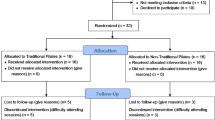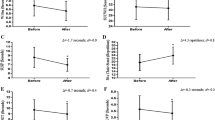Abstract
The adaptations of the human body resulting from the aging process especially loss of flexibility can increase the risk of falls and the risk of developing other health conditions. Exercise training, in particular the Pilates exercise method, has become an important form of physical activity that minimizes the deleterious effects of aging on flexibility. Few studies have evaluated the effect of this training method on body flexibility among elderly. We aimed to evaluate the effects of physical training using the Pilates method on body flexibility of elderly individuals. Eighteen elderly women and two elderly men (aged 70 ± 4 years) followed a 10-week Pilates training program. Individuals were recruited from the local community via open invitations. At study entry, none of them had limited mobility (walking requiring the use of walkers or canes). Furthermore, those with neurologic, muscular, or psychiatric disorders as well as those using an assistive device for ambulation were excluded secondary to limited participation. Flexibility assessment tests (flexion, extension, right and left tilt, and right and left rotation of the cervical and thoracolumbar spine; flexion, extension, abduction, and lateral and medial right and left rotation of the glenohumeral joint; flexion, extension, abduction, adduction, and lateral and medial rotation of the right and left hip; and flexion of the right and left knee) were performed by a blinded evaluator using a flexometer before and after the training period. All assessments were carried out at the same time of day. There was an observed increase in flexion (22.86 %; p < 0.001), extension (10.49 %; p < 0.036), and rotation to the left side (20.45 %; p < 0.019) of the cervical spine; flexion (16.45 %; p < 0.001), extension (23.74 %; p = 0.006), lateral bending right (39.52 %; p < 0.001) and left (38.02 %; p < 0.001), and right rotation (24.85 %; p < 0.001) and left (24.24 %; p < 0.001) of the thoracolumbar spine; flexion (right—8.80 %, p = 0.034; left—7.03 %, p = 0.050), abduction (right—20.69 %, p < 0.001; left—16.26 %, p = 0.005), and external rotation (right—116.07 % and left—143 %; p < 0.001 for both directions) of the glenohumeral joint; flexion (right—15.83 %, p = 0.050; left—9.55 %, p = 0.047) of the hips; and bending (right—14.20 %, p = 0.006; left—15.20 %, p = 0.017) the knees. The joint with the greatest magnitude of improvement was the thoracolumbar spine. Thus, this type of training may minimize the deleterious effects of aging and may improve the functionality of elderly individuals, which would reduce the likelihood of accidents (especially falls).





Similar content being viewed by others
References
ACSM (2011) Manual do ACSM para Avaliação da Aptidão Física Relacionada à Saúde. Guanabara Koogan, Rio de Janeiro
Alves de Araujo ME, Bezerra da Silva E, Bragade Mello D, Cader SA, Shiguemi Inoue Salgado A, Dantas EH (2012) The effectiveness of the Pilates method: reducing the degree of non-structural scoliosis, and improving flexibility and pain in female college students. J Bodyw Mov Ther 16:191–198
Badley EM, Wagstaff S, Wood PH (1984) Measures of functional ability (disability) in arthritis in relation to impairment of range of joint movement. Ann Rheum Dis 43:563–569
Baroni BM, Geremia JM, Rodrigues R, Borges MK, Jinha A, Herzog W, et al. (2013a) Functional and morphological adaptations to aging in knee extensor muscles of physically active men. J Appl Biomech 29:535–542
Baroni BM, Geremia JM, Rodrigues R, De Azevedo Franke R, Karamanidis K, Vaz MA (2013b) Muscle architecture adaptations to knee extensor eccentric training: rectus femoris vs. vastus lateralis. Muscle Nerve 48:498–506
Bassey E, Morgan K, Dallosso H, Ebrahim S (1989) Flexibility of the shoulder joint measured as range of abduction in a large representative sample of men and women over 65 years of age. Eur J Appl Physiol Occup Physiol 58:353–360
Battaglia G, Bellafiore M, Caramazza G, Paoli A, Bianco A, Palma A (2014) Changes in spinal range of motion after a flexibility training program in elderly women. Clin Interv Aging 9:653–660
Borg GA (1982) Psychophysical bases of perceived exertion. Med Sci Sports Exerc 14:377–381
Bullo V, Bergamin M, Gobbo S, Sieverdes JC, Zaccaria M, Neunhaeuserer D, et al. (2015) The effects of Pilates exercise training on physical fitness and wellbeing in the elderly: a systematic review for future exercise prescription. Prev Med 75:1–11
Campos de Oliveira L, Goncalves de Oliveira R, Pires-Oliveira DA (2015) Effects of Pilates on muscle strength, postural balance and quality of life of older adults: a randomized, controlled, clinical trial. J Phys Ther Sci 27:871–876
Clark B, Osness W, Adrian M, Hoeger W, Raab D, Wiswell R (1989) Tests for fitness in older adults. AAHPERD Fitness Task Force. Journal of Physical Education, Recreation & Dance 60:66–71
Coelho CW, de Araújo CGS (2000) Relação entre aumento da flexibilidade e facilitações na execução de ações cotidianas em adultos participantes de programa de exercícios supervisionados. Revista Brasileira de Cineantropometria & Desempenho Humano 2:31–41
da Luz Jr MA, Costa LO, Fuhro FF, Manzoni AC, Oliveira NT, Cabral CM (2014) Effectiveness of mat Pilates or equipment-based Pilates exercises in patients with chronic nonspecific low back pain: a randomized controlled trial. Phys Ther 94:623–631
de Oliveira Gouveia VH, de Figueiredo Araújo AG, dos Santos Maciel S, de Almeida Ferreira JJ, dos Santos HH (2014) Reliability of the measures inter and intra-evaluators with universal goniometer and fleximeter. Fisioterapia e Pesquisa 21:229–235
Doherty TJ (2003) Invited review: aging and sarcopenia. J Appl Physiol (1985) 95:1717–1727
Duclay J, Martin A, Duclay A, Cometti G, Pousson M (2009) Behavior of fascicles and the myotendinous junction of human medial gastrocnemius following eccentric strength training. Muscle Nerve 39:819–827
Emery K, De Serres SJ, McMillan A, Cote JN (2010) The effects of a Pilates training program on arm-trunk posture and movement. Clin Biomech (Bristol, Avon) 25:124–130
Emilio EJ, Hita-Contreras F, Jimenez-Lara PM, Latorre-Roman P, Martinez-Amat A (2014) The association of flexibility, balance, and lumbar strength with balance ability: risk of falls in older adults. J Sports Sci Med 13:349–357
Fabre JM, Wood RH, Cherry KE, Su JL, Cress EM, King CM, et al. (2007) Age-related deterioration in flexibility is associated with health-related quality of life in nonagenarians. J Geriatr Phys Ther 30:16–22
Florêncio LL, Pereira PA, Silva ERT, Pegoretti KS, Gonçalves MC, Bevilaqua-Grossi D (2010) Agreement and reliability of two non-invasive methods for assessing cervical range of motion among young adults. Brazilian Journal of Physical Therapy 14:175–181
Fowles JR, Sale DG, MacDougall JD (2000) Reduced strength after passive stretch of the human plantarflexors. J Appl Physiol (1985) 89:1179–1188
Freitas SR, Mil-Homens P (2014) Effect of 8-week high-intensity stretching training on biceps femoris architecture. J Strength Cond Res
Granacher U, Gollhofer A, Hortobagyi T, Kressig RW, Muehlbauer T (2013) The importance of trunk muscle strength for balance, functional performance, and fall prevention in seniors: a systematic review. Sports Med 43:627–641
Guissard N, Duchateau J (2006) Neural aspects of muscle stretching. Exerc Sport Sci Rev 34:154–158
Holland GJ, Tanaka K, Shigematsu R, Nakagaichi M (2002) Flexibility and physical functions of older adults: a review. J Aging Phys Act 10:169–206
IBGE (2009) Diretoria de Pesquisas. Coordenação de População e Indicadores Sociais. Estudos e Pesquisas. Informação Demográfica e Socioeconômica. Perfil dos idosos responsáveis pelos domicílios no Brasil
IBGE (2010). Diretoria de Pesquisas. Coordenação de População e Indicadores Sociais. Estudos e Pesquisas. Informação Demográfica e Socioeconômica. Síntese de Indicadores Sociais
Imagama S, Matsuyama Y, Hasegawa Y, Sakai Y, Ito Z, Ishiguro N, et al. (2011) Back muscle strength and spinal mobility are predictors of quality of life in middle-aged and elderly males. Eur Spine J 20:954–961
Iwamoto J, Suzuki H, Tanaka K, Kumakubo T, Hirabayashi H, Miyazaki Y, et al. (2009) Preventative effect of exercise against falls in the elderly: a randomized controlled trial. Osteoporos Int 20:1233–1240
Johnson EG, Larsen A, Ozawa H, Wilson CA, Kennedy KL (2006) The effects of Pilates-based exercise on dynamic balance in healthy adults. J Bodyw Mov Ther 11:238–242
Kado DM, Huang MH, Karlamangla AS, Barrett-Connor E, Greendale GA (2004) Hyperkyphotic posture predicts mortality in older community-dwelling men and women: a prospective study. J Am Geriatr Soc 52:1662–1667
Kibar, S., Yardimci, F., Evcik, D., Ay, S., Alhan, A., Manço, M., et al. (2015). Is Pilates exercise program effective on balance, flexibility and muscle endurance? Randomized, controlled study. J Sports Med Phys Fitness, Epub ahead of print
Kibler WB, Press J, Sciascia A (2006) The role of core stability in athletic function. Sports Med 36:189–198
Konrad A, Tilp M (2014) Increased range of motion after static stretching is not due to changes in muscle and tendon structures. Clin Biomech (Bristol, Avon) 29:636–642
Kraemer WJ, Ratamess NA (2004) Fundamentals of resistance training: progression and exercise prescription. Med Sci Sports Exerc 36:674–688
Kubo K, Kanehisa H, Azuma K, Ishizu M, Kuno SY, Okada M, et al. (2003) Muscle architectural characteristics in young and elderly men and women. Int J Sports Med 24:125–130
Lan C, Chen SY, Lai JS (2008) Changes of aerobic capacity, fat ratio and flexibility in older TCC practitioners: a five-year follow-up. Am J Chin Med 36:1041–1050
Leighton JR (1987) Manual of instruction for Leighton flexometer, New York
Lima KM, Carneiro SP, Alves Dde S, Peixinho CC, de Oliveira LF (2015) Assessment of muscle architecture of the biceps femoris and vastus lateralis by ultrasound after a chronic stretching program. Clin J Sport Med 25:55–60
Magnusson SP, Simonsen EB, Aagaard P, Sorensen H, Kjaer M (1996) A mechanism for altered flexibility in human skeletal muscle. J Physiol 497(Pt 1):291–298
Morse CI, Thom JM, Birch KM, Narici MV (2005) Changes in triceps surae muscle architecture with sarcopenia. Acta Physiol Scand 183:291–298
Mota J, Ribeiro JL, Carvalho J, Matos MG (2006) Atividade física e qualidade de vida associada à saúde em idosos participantes e não participantes em programas regulares de atividade física. Rev Bras Educ Fís Esp 20:219–225
Narici MV, Maganaris CN, Reeves ND, Capodaglio P (2003) Effect of aging on human muscle architecture. J Appl Physiol (1985) 95:2229–2234
Plachy J, Kovách M, Bognár J (2012) Improving flexibility and endurance of elderly women through a six-month training programme. Human Movement 13:22–27
Potier TG, Alexander CM, Seynnes OR (2009) Effects of eccentric strength training on biceps femoris muscle architecture and knee joint range of movement. Eur J Appl Physiol 105:939–944
Richardson C, Jull G, Hodges P, Hides J (1999) Therapeutic exercise for spinal segmental stabilization in low back pain: scientific basis and clinical approach. Churchill Livingstone, Edinburgh
Rosenberg IH (2011) Sarcopenia: origins and clinical relevance. Clin Geriatr Med 27:337–339
Segal NA, Hein J, Basford JR (2004) The effects of Pilates training on flexibility and body composition: an observational study. Arch Phys Med Rehabil 85:1977–1981
Sekendiz B, Altun Ö, Korkusuz F, Akın S (2007) Effects of Pilates exercise on trunk strength, endurance and flexibility in sedentary adult females. J Bodyw Mov Ther 11:318–326
Skelton DA (2001) Effects of physical activity on postural stability. Age Ageing 30(4):33–39
Spirduso W, Francis K, Francis P (1995) Physical dimensions of aging. Champaign, IL, Human Kinetics
USA (2013) Department of economic and social affairs, population division: world population prospects: the 2012 revision, New York
Vieira DC, Tibana RA, Tajra V, Nascimento Dda C, de Farias DL, Silva Ade O, et al. (2013) Decreased functional capacity and muscle strength in elderly women with metabolic syndrome. Clin Interv Aging 8:1377–1386
Zatsiorsky V, Kraemer W (2006) Science and practice of strength training. Champaign, IL, Human Kinetics
Author information
Authors and Affiliations
Corresponding author
About this article
Cite this article
Geremia, J.M., Iskiewicz, M.M., Marschner, R.A. et al. Effect of a physical training program using the Pilates method on flexibility in elderly subjects. AGE 37, 119 (2015). https://doi.org/10.1007/s11357-015-9856-z
Received:
Accepted:
Published:
DOI: https://doi.org/10.1007/s11357-015-9856-z




